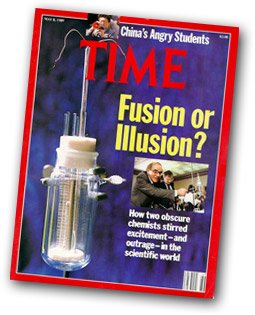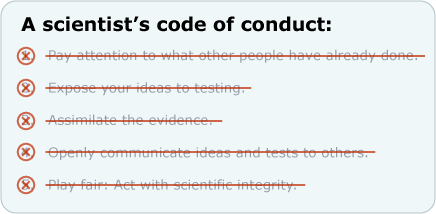One year after the press conference that had garnered Pons and Fleischmann so much attention, the scientific process had finally been able to sort through the evidence regarding cold fusion. Few groups had found support for the hypothesis, and those few had inconsistent results and could not reliably reproduce their findings. This lack of replicable evidence was a major blow for cold fusion. The laws of nature don’t play favorites. If cold fusion works in one laboratory under a certain set of conditions, we’d expect it to work in other laboratories at other times under the same conditions. Hence, lack of reproducibility is a serious problem for any scientific finding, casting doubt on the validity of the original result and suggesting that there’s been a misinterpretation of what’s going on. In Pons and Fleischmann’s case, lack of reproducibility indicated that whatever it was they had originally detected, it probably wasn’t cold fusion. This interpretation is also supported by the fact that independent scientists couldn’t find any evidence that Pons and Fleischmann’s own cells had actually produced fusion. In light of all this evidence, most scientists consider Pons and Fleischmann’s results to be an experimental error.
 An error like this would normally be detected before it caused an uproar in the scientific and broader communities. However, in the case of cold fusion, the checks inherent in the process of science were weakened when Pons, Fleischmann, and others caught up in the excitement broke with norms for good scientific conduct. While the process of science is resilient to a single, or even a few divergences from best practices, the convergence of multiple infractions can hinder the process. The journal editor who allowed the original article to be published with minimal peer review did not adhere to the standards science had set for such publications. Pons and Fleischmann withheld experimental details from the community and tried to shield their ideas from testing. They and the other scientists who “reproduced” cold fusion, only to later retract their results, failed to perform adequate tests to evaluate their ideas. And, of course, Pons’ behavior during the helium experiment, as well as the broken publication agreement with Jones, smacked of dishonesty. It’s important to note that even with such unscientific behavior, the process of science still worked. Within a year, the scientific community had investigated Pons and Fleischmann’s claims and come to the consensus that what had been observed wasn’t really cold fusion. However, there was still a price to pay for this misconduct: time, energy, and upwards of 100 million tax dollars were squandered on cold fusion.
An error like this would normally be detected before it caused an uproar in the scientific and broader communities. However, in the case of cold fusion, the checks inherent in the process of science were weakened when Pons, Fleischmann, and others caught up in the excitement broke with norms for good scientific conduct. While the process of science is resilient to a single, or even a few divergences from best practices, the convergence of multiple infractions can hinder the process. The journal editor who allowed the original article to be published with minimal peer review did not adhere to the standards science had set for such publications. Pons and Fleischmann withheld experimental details from the community and tried to shield their ideas from testing. They and the other scientists who “reproduced” cold fusion, only to later retract their results, failed to perform adequate tests to evaluate their ideas. And, of course, Pons’ behavior during the helium experiment, as well as the broken publication agreement with Jones, smacked of dishonesty. It’s important to note that even with such unscientific behavior, the process of science still worked. Within a year, the scientific community had investigated Pons and Fleischmann’s claims and come to the consensus that what had been observed wasn’t really cold fusion. However, there was still a price to pay for this misconduct: time, energy, and upwards of 100 million tax dollars were squandered on cold fusion.

Pons and Fleischmann also did damage that is harder to quantify. Perhaps most worrying is the effect that this debacle had on the public’s perception of science. Pons and Fleischmann’s unclear statements at the press conference, which emphasized only the future benefits of cold fusion and not the early stage of the investigation, contributed to the media hype and raised society’s expectations without warrant. These unmet expectations coupled with accusations of fraud and dishonesty damaged the public’s trust in science. Because science is so deeply intertwined with the broader community, scientific misbehavior has implications far beyond the group of physicists and chemists who study cold fusion.
Despite all this, some scientists continue to investigate the possibility of cold fusion. Science doesn’t give up on ideas that have merit, even if they experience setbacks. All scientific knowledge is, after all, tentative. So though there is every reason to think that what Pons and Fleischmann observed was not cold fusion, some scientists (though a small minority of the physics community) continue to investigate whether or not cold fusion is possible. But to convince the rest of the physics community, they’ll need to find many lines of solid evidence to support their views.
Popular and historical accounts:
- Huizenga, J. 1993. Cold Fusion: The Scientific Fiasco of the Century. New York: University of Rochester Press.
- Taubes, G. 1993. Bad Science: The Short Life and Weird Times of Cold Fusion. New York: Random House.
Some scientific papers:
- Fleischmann, M., and S. Pons. 1989. Electrochemically induced nuclear fusion of deuterium. Journal of Electroanalytical Chemistry 261:301-308.
- Jones, S.E., E.P. Palmer, J.B. Czirr, D.L. Decker, G.L. Jensen, J.M. Thorne, S.F. Taylor, and J. Rafelski. 1989. Observation of cold nuclear fusion in condensed matter. Nature 388:737-740.
